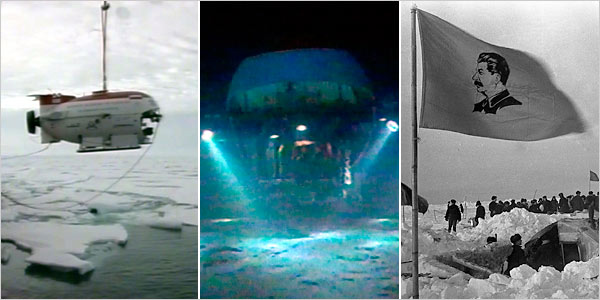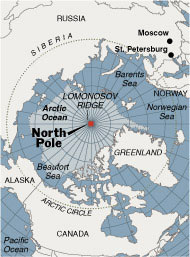 |
 |
| Want to send this page or a link to a friend? Click on mail at the top of this window. |
| Posted Friday, August 3, 2007 |
Russians Plant Flag on the Arctic Seabed |
|||
 |
|||
|
|||
| At left, one of two Russian submarines was lowered into the Arctic Ocean on Thursday. Television showed the two Russian submarines on the seabed to plant the flag, center. The ships were more than two miles under the Arctic ice cap. At right, a polar expedition was sent by the Soviet Union in 1938 to rescue the crew of a research station that had been sent there the previous year. |
By C.J. CHIVERS |
MOSCOW, Aug. 2 — A Russian expedition descended in a pair of submersible vessels more than two miles under the ice cap on Thursday and deposited a Russian flag on the seabed at the North Pole. The dive was a symbolic move to enhance the government’s disputed claim to nearly half of the floor of the Arctic Ocean and potential oil or other resources there.
The expedition, covered intensely by Russian news organizations and state-controlled television, mixed high-seas adventure with the long Russian tradition of polar exploration. But it was also an openly choreographed publicity stunt.
Inside the first of the mini-submarines to reach the sea floor were two members of Russia’s lower house of Parliament. One of them, Artur N. Chilingarov, led the expedition to seek evidence reinforcing Russia’s claim over the largely uncharted domain. That claim, which has no current legal standing, rests on a Russian assertion that the seabed under the pole, called the Lomonosov Ridge, is an extension of Russia’s continental shelf and thus Russian territory.
 |
The New York Times |
At least one country with a stake in the issue registered its immediate disapproval of the expedition. “This isn’t the 15th century,” Peter MacKay, Canada’s foreign minister, said on CTV television. “You can’t go around the world and just plant flags and say, ‘We’re claiming this territory.’ ”
Russia submitted its claim in 2001 to an international commission, which has ruled that the available data is not sufficient to support it. But Russia has pressed on.
“We must determine the border, the most northerly of the Russian shelf,” Mr. Chilingarov said on national television before the dive, which was billed as the first of its sort — a descent into the inky darkness far beneath a large window cut into the ice sheet by a nuclear-powered ice breaker.
After resurfacing more than eight hours later, Mr. Chilingarov spoke as if he had been the first to the moon. “If a hundred or a thousand years from now someone goes down to where we were, they will see the Russian flag,” he said. The flag is reproduced in titanium. He later added, “Our task is to remind the world that Russia is a great Arctic and scientific power.”
The day’s events underscored both Russia’s restored sense of confidence and the international competition for access, influence and extraction rights in the far north, which has intensified as oil and gas prices have surged and as trends in global warming have encouraged speculation that the region could become more navigable.
President Vladimir V. Putin called the members of the expedition to thank them personally, an unmistakable sign of the significance of the claim to the Kremlin, which has reestablished itself as a world power in recent years in part through its control of its oil, gas, minerals and other commodities.
Five countries — Canada, Denmark, Norway, Russia and the United States — have territory in the Arctic Circle and under international convention have rights to economic zones within 200 miles of their borders. Denmark has sent its own scientific expeditions to study the opposite end of the ocean-spanning ridge and to seek proof that it is torn from the continental shelf north of Greenland, which is a Danish territory.
Several other countries seek to extend their influence in the circle, seeing the mostly unpopulated region’s potential for providing a hydrocarbon and mineral rush. The ultimate demarcation, if geologists’ estimates of its deposits prove true, could be a key to future national wealth and power.
Russia’s foreign minister, Sergey V. Lavrov, speaking from the Philippines, ignored criticism, saying that Russia’s claims were sound and in time could be established as fact.
“The goal of this expedition is not to stake out Russia’s rights, but to prove that our shelf stretches up to the North Pole,” he said on Radio Mayak. “There are concrete scientific methods for this.”
The expedition mixed public and private financing, much of which Mr. Chilingarov raised. Any new evidence it collected for the Russian government would eventually have to be submitted to a commission on continental shelf borders, which is elected by members of the United Nations Convention on the Law of the Sea.
Russia has a long tradition of northern exploration and extraction, and since early Soviet times the Kremlin has had research stations on the Arctic ice. Stalin first dispatched a team in 1937, at the height of the Great Terror.
Whatever the merits of any future submission, Russian scientists marveled at the expedition on Thursday, which involved two small submarines, known as the Mir-1 and Mir-2, descending from a drifting, shifting ice pack to the sea floor more than 14,000 feet beneath the surface.
The pair spent about an hour on the sea floor and left behind the reproduction of the Russian tricolor flag at 1:36 p.m., Moscow time, according to Russia’s official news agency.
Then they ascended, which the scientists said was the most difficult task, because they had to find their way back to the hole on the surface. The submarines are too small to break through the ice on their own, and errant navigation could have left them trapped beneath the cap.
Once news reached Moscow that the journey had succeeded, scientists spoke with evident pride. “We can say that is a great technical and technological achievement,” said Leopold I. Lobkovsky, deputy director of geological studies at the P. P. Shirshov Institute of Oceanology here, which provided a research vessel for the expedition.
Another scientist, Ivan Y. Frolov, director of the Arctic and Antarctic Research Institute in St. Petersburg, cautioned that whatever the brief dive had found, it would do little to settle disputes about future demarcation. But he noted certain values in the event, which was one element in the annual summer expedition to study climate, the sea and the ice.
“I doubt that this one submersion will make a breakthrough in the problem that is being discussed in the media,” he said. “It was a good chance to demonstrate the capabilities of this equipment and the depths that can be reached, and to demonstrate the courage of Mr. Chilingarov, which is great.”
Andrew C. Revkin contributed reporting from New York.
Copyright 2007 The New York Times Company. Reprinted from The New York Times, Science, of Friday, August 3, 2007.
| Wehaitians.com, the scholarly journal of democracy and human rights |
| More from wehaitians.com |